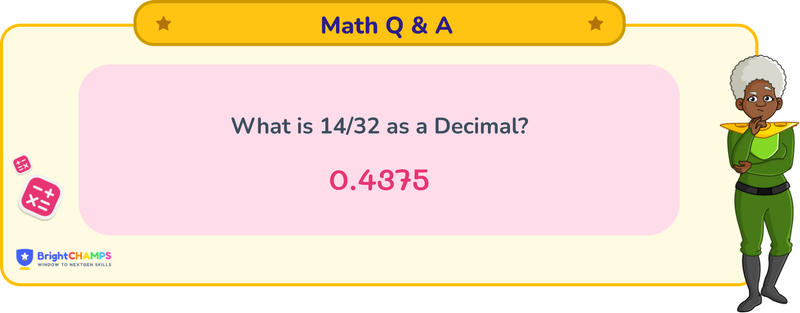
 169 Learners
169 LearnersLast updated on May 26th, 2025

14/32 as a Decimal

This is a simple question on decimal conversion. Firstly, we need to understand fractions and decimals. A fraction represents a part of a whole. It has two parts: the numerator (the number on the top), in this case, 14, which shows how many parts of the whole are being considered. The denominator (the number below) shows how many parts make up the whole, here it is 32. A decimal is a way to represent a number that is not whole, using a (.) or a decimal point to separate the whole part from the fractional part. The numbers to the left of the decimal point represent the whole, and those to the right represent the fractional part.
What is 14/32 as a decimal?

Answer
14/32 in decimals can be written as 0.4375. It is a terminating decimal, meaning it does not repeat infinitely.
Explanation
To convert 14/32 into a decimal, we use the division method. Since 14 is smaller than 32, the quotient will be less than 1. Let's see the step-by-step process:
Step 1: Identify the numerator and denominator. The numerator (14) will be taken as the dividend, and the denominator (32) will be taken as the divisor.
Step 2: Divide 14 by 32. Since 14 is smaller than 32, we will use decimals. We add a decimal point in the quotient place and append zeros to the dividend.
Step 3: 140 divided by 32 gives 4 as the quotient (4 * 32 = 128). We subtract 128 from 140 to get a remainder of 12.
Step 4: Bring down another 0 to make it 120. Then, 120 divided by 32 gives 3 as the quotient (3 * 32 = 96). Subtract 96 from 120 to get a remainder of 24.
Step 5: Bring down another 0 to make it 240. Then, 240 divided by 32 gives 7 as the quotient (7 * 32 = 224). Subtract 224 from 240 to get a remainder of 16.
Step 6: Bring down another 0 to make it 160. Then, 160 divided by 32 gives 5 as the quotient (5 * 32 = 160). Subtract 160 from 160 to get a remainder of 0. The division process ends here with no remainder, making it a terminating decimal.
Thus, 14/32 as a decimal is 0.4375.
Struggling with Math?
Get 1:1 Coaching to Boost Grades Fast !

Important Glossaries for 14/32 as a decimal
- Fraction: A numerical quantity that is not a whole number, representing a part of a whole.
- Decimal: A number that uses the base ten and includes a decimal point to separate the whole part from the fractional part.
- Numerator: The top part of a fraction, indicating how many parts of the whole are being considered.
- Denominator: The bottom part of a fraction, showing how many parts make up a whole.
- Terminating Decimal: A decimal that ends and does not repeat infinitely.




